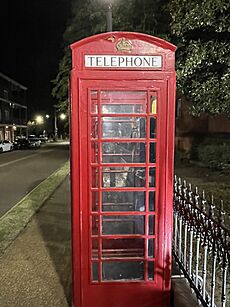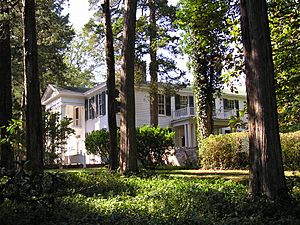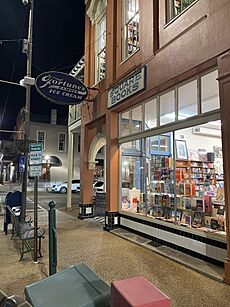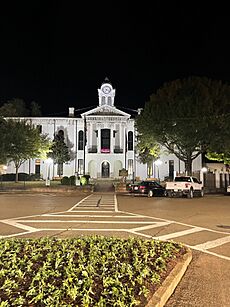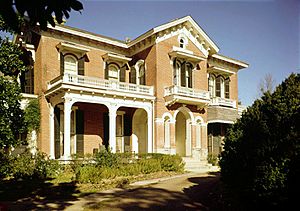Oxford, Mississippi facts for kids
Quick facts for kids
Oxford, Mississippi
|
|||
|---|---|---|---|
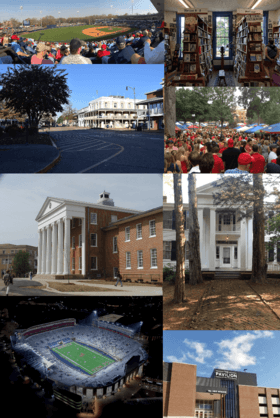
From top, left to right: Swayze Field, Square Books, Oxford's downtown Square, The Grove at Ole Miss, The Lyceum at the University of Mississippi, Rowan Oak, Vaught–Hemingway Stadium, The Sandy and John Black Pavilion at Ole Miss
|
|||
|
|||
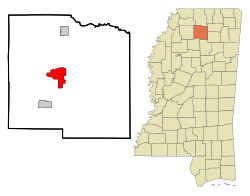
Location of Oxford, Mississippi
|
|||
| Country | United States | ||
| State | Mississippi | ||
| County | Lafayette | ||
| Named for | Oxford, England | ||
| Area | |||
| • Total | 26.71 sq mi (69.18 km2) | ||
| • Land | 26.62 sq mi (68.94 km2) | ||
| • Water | 0.09 sq mi (0.24 km2) | ||
| Elevation | 449 ft (137 m) | ||
| Population
(2020)
|
|||
| • Total | 25,416 | ||
| • Density | 954.88/sq mi (368.68/km2) | ||
| Time zone | UTC−6 (Central (CST)) | ||
| • Summer (DST) | UTC−5 (CDT) | ||
| ZIP Code |
38655
|
||
| Area code(s) | 662 | ||
| FIPS code | 28-54840 | ||
| GNIS feature ID | 2404454 | ||
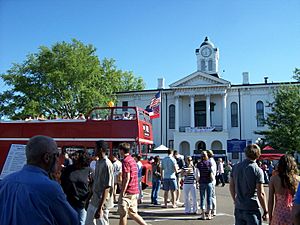
Oxford is a city in Mississippi, United States. It is the 14th largest city in the state. Oxford is the main city of Lafayette County. It is about 75 miles (120 km) southeast of Memphis.
Oxford is known as a college town. It is home to the University of Mississippi, often called "Ole Miss". The city was started in 1837. It was named after Oxford, England, because its founders hoped it would become a learning center.
In 1841, Mississippi chose Oxford for its first university. The city is also famous as the home of Nobel Prize-winning writer William Faulkner. His fictional "Jefferson in Yoknapatawpha County" was inspired by Oxford. Lucius Quintus Cincinnatus Lamar, a US Supreme Court Justice, also lived and is buried here. In 2020, Oxford had a population of 25,416 people.
Contents
Exploring Oxford's Past
How Oxford Began
Oxford and Lafayette County were created from land given up by the Chickasaw people. This happened in 1832 with the Treaty of Pontotoc Creek. The county was officially formed in 1836. In 1837, three pioneers bought land from a Chickasaw woman named Hoka. They wanted to build a town there. They named it "Oxford" to show their goal of making it a place for learning. In 1841, the Mississippi government chose Oxford for the state university. The university opened in 1848.
Oxford During the Civil War
During the American Civil War, Union Army troops came to Oxford. Generals Ulysses S. Grant and William T. Sherman were there in 1862. In 1864, Major General Andrew Jackson Smith burned many buildings in the town square. This included the county courthouse. After the war, the town slowly rebuilt. A federal judge, Robert Andrews Hill, helped get money for a new courthouse in 1872.
After the war, many African Americans who had been enslaved moved to Oxford. They created a neighborhood called "Freedmen Town". Here, they built homes, businesses, churches, and schools. They also used their rights as U.S. citizens. Even when Mississippi made laws in the 1890s to stop many African Americans from voting, they kept working to build their lives.
The Civil Rights Movement in Oxford
Oxford became well-known during the Civil Rights Movement. This was because of events at the Ole Miss riot of 1962. State officials, like Governor Ross Barnett, tried to stop James Meredith, an African American, from joining the University of Mississippi. This happened even after federal courts said he should be allowed to enroll.
President John F. Kennedy sent federal officers to help Meredith. Many people who supported segregation came to Oxford. When Meredith arrived to register, riots broke out. Cars were burned, and federal officers were attacked. Two people were killed. The riot spread into parts of Oxford city. Finally, federal troops arrived and brought order back to the campus.
Oxford in the 21st Century
In 2008, Oxford hosted a major event. More than 3,000 journalists came to cover the first presidential debate of 2008. This important debate was held at the University of Mississippi.
Oxford's Location and Landscape
Oxford is located in the middle of Lafayette County, in northern Mississippi. It is about 75 miles (120 km) south-southeast of Memphis, Tennessee.
The city covers about 26.7 square miles (69.2 square kilometers). Most of this area is land. The campus of the University of Mississippi is next to downtown Oxford. It is an area surrounded by the city but not officially part of it.
Oxford is in the North Central Hills region of Mississippi. This area has many hills covered in forests and red clay. The city's elevation changes can be seen when driving on Highway 6. Downtown Oxford and the University are on hills, while main shopping areas are in valleys.
Many highways meet in Oxford. Mississippi Highway 6 (also called US-278) goes west to Batesville and east to Pontotoc. Highway 7 goes north to Holly Springs and south to Water Valley. Other highways connect Oxford to nearby towns and Sardis Lake.
The streets in downtown Oxford are set up in a grid. North-south streets are numbered. East-west streets are named after U.S. presidents.
Oxford's Climate
Oxford has a humid subtropical climate. This means it has hot, humid summers and mild winters. It is in hardiness zone 7b, which describes how cold it gets for plants.
| Climate data for Oxford, Mississippi (University of Mississippi) 1991–2020, extremes 1893–present | |||||||||||||
|---|---|---|---|---|---|---|---|---|---|---|---|---|---|
| Month | Jan | Feb | Mar | Apr | May | Jun | Jul | Aug | Sep | Oct | Nov | Dec | Year |
| Record high °F (°C) | 80 (27) |
83 (28) |
91 (33) |
93 (34) |
98 (37) |
104 (40) |
108 (42) |
107 (42) |
111 (44) |
98 (37) |
87 (31) |
81 (27) |
110 (43) |
| Mean daily maximum °F (°C) | 52.3 (11.3) |
57.1 (13.9) |
65.8 (18.8) |
74.2 (23.4) |
82.0 (27.8) |
88.6 (31.4) |
91.3 (32.9) |
91.0 (32.8) |
86.2 (30.1) |
76.1 (24.5) |
64.3 (17.9) |
55.0 (12.8) |
73.7 (23.2) |
| Daily mean °F (°C) | 41.4 (5.2) |
45.4 (7.4) |
53.5 (11.9) |
61.6 (16.4) |
70.4 (21.3) |
77.7 (25.4) |
80.7 (27.1) |
79.8 (26.6) |
73.9 (23.3) |
62.6 (17.0) |
51.9 (11.1) |
44.2 (6.8) |
61.9 (16.6) |
| Mean daily minimum °F (°C) | 30.6 (−0.8) |
33.8 (1.0) |
41.2 (5.1) |
48.9 (9.4) |
58.9 (14.9) |
66.8 (19.3) |
70.2 (21.2) |
68.6 (20.3) |
61.6 (16.4) |
49.2 (9.6) |
39.5 (4.2) |
33.3 (0.7) |
50.2 (10.1) |
| Record low °F (°C) | −13 (−25) |
−10 (−23) |
7 (−14) |
21 (−6) |
31 (−1) |
43 (6) |
50 (10) |
48 (9) |
32 (0) |
20 (−7) |
6 (−14) |
−10 (−23) |
−13 (−25) |
| Average precipitation inches (mm) | 5.13 (130) |
5.82 (148) |
5.61 (142) |
6.30 (160) |
5.35 (136) |
5.22 (133) |
4.35 (110) |
3.90 (99) |
3.99 (101) |
4.10 (104) |
4.30 (109) |
6.45 (164) |
60.52 (1,537) |
| Average snowfall inches (cm) | 0.8 (2.0) |
0.2 (0.51) |
0.1 (0.25) |
0.0 (0.0) |
0.0 (0.0) |
0.0 (0.0) |
0.0 (0.0) |
0.0 (0.0) |
0.0 (0.0) |
0.0 (0.0) |
0.0 (0.0) |
0.1 (0.25) |
1.2 (3.0) |
| Average precipitation days (≥ 0.01 in) | 12.0 | 10.8 | 11.7 | 10.3 | 11.0 | 10.2 | 10.0 | 8.8 | 7.4 | 7.9 | 9.8 | 12.2 | 122.1 |
| Average snowy days (≥ 0.1 in) | 0.6 | 0.4 | 0.1 | 0.0 | 0.0 | 0.0 | 0.0 | 0.0 | 0.0 | 0.0 | 0.0 | 0.3 | 1.4 |
| Source: NOAA | |||||||||||||
People of Oxford
| Historical population | |||
|---|---|---|---|
| Census | Pop. | %± | |
| 1850 | 492 | — | |
| 1870 | 1,422 | — | |
| 1880 | 1,534 | 7.9% | |
| 1890 | 1,546 | 0.8% | |
| 1900 | 1,820 | 17.7% | |
| 1910 | 2,014 | 10.7% | |
| 1920 | 2,150 | 6.8% | |
| 1930 | 2,890 | 34.4% | |
| 1940 | 3,433 | 18.8% | |
| 1950 | 3,956 | 15.2% | |
| 1960 | 5,283 | 33.5% | |
| 1970 | 8,519 | 61.3% | |
| 1980 | 9,882 | 16.0% | |
| 1990 | 9,984 | 1.0% | |
| 2000 | 11,756 | 17.7% | |
| 2010 | 18,916 | 60.9% | |
| 2020 | 25,416 | 34.4% | |
| U.S. Decennial Census | |||
Population in 2020
In 2020, Oxford had 25,416 people living in 10,351 households.
| Race | Number | Percent |
|---|---|---|
| White | 16,559 | 65.15% |
| Black or African American | 5,656 | 22.25% |
| Native American | 12 | 0.05% |
| Asian | 1,279 | 5.03% |
| Pacific Islander | 7 | 0.03% |
| Other/mixed | 861 | 3.39% |
| Hispanic or Latino | 1,042 | 4.1% |
Population in 2010
In 2010, there were 18,916 people and 8,648 households in Oxford.
- About 72.3% of the people were White.
- About 21.8% were African American.
- About 3.3% were Asian.
- About 2.5% were Hispanic or Latino.
The average household income was $64,643. About 32.3% of the population lived below the poverty line.
Arts and Culture in Oxford
Popular Attractions
The historic Lafayette County Courthouse is a key landmark. The Square area around it has many local restaurants, unique shops, and offices.
- The J. E. Neilson Co. is the oldest store in the South. It started as a trading post in 1839. Neilson's was one of the few stores that survived when Oxford was burned during the Civil War. It even acted like a bank during the Great Depression.
- Square Books opened in 1979. It is a famous independent bookstore. There are also "Off Square Books" for used books and "Square Books Jr." for children's books. Off Square Books hosts a radio show called Thacker Mountain Radio.
- The Lyric Theater is Oxford's biggest music venue. It can hold about 1200 people. It was once a stable owned by William Faulkner's family. In the 1920s, it became Oxford's first movie theater. It reopened in 2008 for live music, films, and plays.
- The Gertrude Castellow Ford Center for the Performing Arts is on the University of Mississippi campus. It hosts many events, like concerts, operas, plays, and comedy shows. It also hosted the 2008 presidential debate.
- The University of Mississippi Museum is also on campus. It has collections of Greek and Roman artifacts. It also displays 19th-century scientific tools. Entry to the permanent exhibits is free.
- The Burns-Belfry Museum was once a church built by African Americans in 1910. Now, it tells the story of African American history. Its exhibits cover slavery through the Civil Rights Movement.
Oxford's Music and Film Scene
Oxford has a lively music scene. Its location near Memphis, New Orleans, and Nashville influences its music. Many musicians have lived in Oxford, including Beanland and Blue Mountain.
- The music label Fat Possum Records is based in Oxford. They have released music by blues legends like R. L. Burnside.
- Musicians like Modest Mouse and Elvis Costello have recorded albums at Sweet Tea Recording Studio in Oxford. The studio owner, Dennis Herring, has won Grammy awards.
- Bob Dylan wrote a song called "Oxford Town" in 1963. It was about the events when James Meredith joined the University of Mississippi.
- Oxford has been the setting for many movies. These include Intruder in the Dust (1949) and parts of The People vs. Larry Flynt (1997).
Historic Places to Visit
Oxford has many historic sites listed on the National Register of Historic Places listings in Lafayette County, Mississippi.
- Ammadelle (Pegues House), built in 1859. It was designed by Calvert Vaux, who also helped design Central Park.
- Barnard Observatory (1859) is on the University of Mississippi campus.
- Isom Place, built around 1843.
- Lafayette County Courthouse, built in 1872.
- Lucius Q. C. Lamar House, built around 1860. It was restored as a museum in 2008.
- The Lyceum (1848) is the oldest building at the University of Mississippi.
- Rowan Oak (1848) was the home of writer William Faulkner.
- St. Peter's Episcopal Church (1860) is known for its Neo-Gothic style.
- University of Mississippi Power House is a building mentioned in William Faulkner's novel As I Lay Dying.
- Ventress Hall (1889) is another historic building at the University of Mississippi.
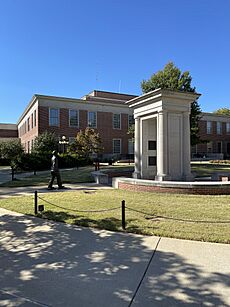
Education in Oxford
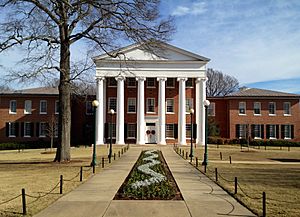
Oxford has two public school districts:
- Oxford School District, which includes Oxford High School.
- Lafayette County School District, which serves some outer areas.
There are also three private schools:
- Oxford University School
- Regents School of Oxford
- Magnolia Montessori
Oxford is home to the main campus of the University of Mississippi, or "Ole Miss". Part of the campus is in University, Mississippi, which is a small area surrounded by Oxford. The Lafayette-Yalobusha Center of Northwest Mississippi Community College is also in Oxford.
The North Mississippi Japanese Supplementary School, a Japanese weekend school, holds classes on the University of Mississippi campus.
Media in Oxford
- The Oxford Eagle, a newspaper started in 1865.
- The Daily Mississippian, the student newspaper of the University of Mississippi, started in 1911.
- The Local Voice, a guide and newspaper about entertainment.
- WUMS, the student radio station of the University of Mississippi.
Getting Around Oxford
Transportation Options
Oxford has a public transportation system called Oxford-University Transit (OUT). It has bus routes throughout the city and the University of Mississippi campus. Students and faculty of Ole Miss can ride for free with their university ID.
The Mississippi Central Railroad provides freight train service. It goes to the Lafayette County Industrial Park in Oxford.
University-Oxford Airport is a public airport. It is located about 2 nautical miles (4 km) northwest of downtown Oxford. The University of Mississippi owns this airport.
Famous People from Oxford

- William Faulkner grew up in Oxford. He used the city as the setting for his fictional town of "Jefferson" in his books.
- Many other authors have lived in Oxford, including John Grisham, Julie Cantrell, and Kiese Laymon.
- Artists like painter Glennray Tutor and primitive artist Theora Hamblett (1895–1977) are from Oxford.
- Jacob Thompson (1810–1885), a former Secretary of the Interior, owned a home in Oxford.
- L.Q.C. Lamar (1825–1893) was a U.S. senator and Supreme Court Justice. He lived in Oxford and was a professor at the University of Mississippi.
- Naomi Sims (1948–2009), a famous fashion model, was born in Oxford.
- Eli Manning, a former New York Giants quarterback, played college football at Ole Miss. He lives in Oxford during the off-season. His father, Archie Manning, also a famous quarterback, owns a home in Oxford.
Sister City
Oxford has a sister city in France:
 Aubigny-sur-Nère, Cher, France
Aubigny-sur-Nère, Cher, France
See also
 In Spanish: Oxford (Misisipi) para niños
In Spanish: Oxford (Misisipi) para niños





